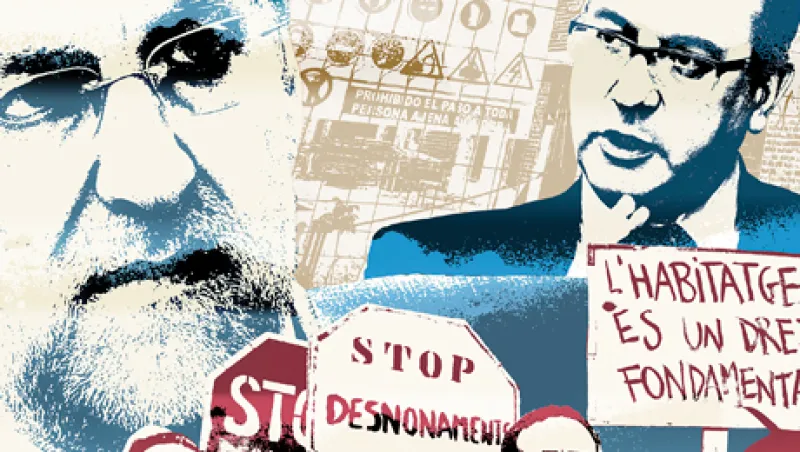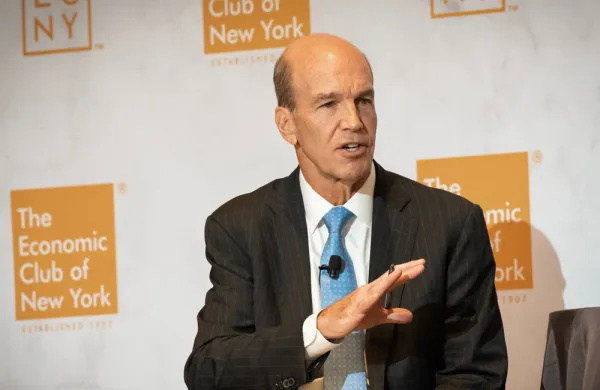ONLY FOUR YEARS AGO, when Spain’s property market was still booming, some bank branches could easily have been mistaken for real estate brokerages. The spacious lobby of the Banco Bilbao Vizcaya Argentaria branch on Calle de Alcalá in the heart of Madrid exhibited a large model of vacation and retirement apartment towers that Spain’s second-largest bank had financed on the sunny Mediterranean coast and was filling with BBVA mortgage holders. Today, Spanish banks have banished development projects from their lobbies. Getting them off their balance sheets is proving to be far more difficult. The collapse of the property market has left the coast littered with half-finished condominium high-rises and turned many of the country’s lenders, especially savings banks known as cajas, into zombie banks. The banking system has extended more than €300 billion ($400 billion) in loans—roughly equivalent to one third of the country’s gross domestic product—to real estate developers, many of which are now deep underwater if not bankrupt.

|
In his campaign Rajoy, an uncharismatic but dogged politician, promised to reduce the deficit to 4.4 percent of GDP by the end of 2012. That won’t be easy, considering that he has also promised not to raise taxes. The deficit, which stood at 9.2 percent in 2010, looks set to easily exceed Zapatero’s 6 percent target for 2011; economists at Citigroup project the deficit will hit 8.1 percent. The combination of public spending cuts and restricted bank lending is throttling the economy, which showed zero growth in the third quarter, and aggravating the country’s fiscal woes. “There already is a credit crunch for households and small and medium enterprises,” de Guindos tells Institutional Investor.
The same goes for the government. Just two days after the election, the yield on the government’s ten-year bonds surged to 6.65 percent, or 474 basis points more than German bonds—both figures close to euro-era highs. The markets all but ignored the fact that Spain’s public-debt-to-GDP ratio is only 65 percent, barely half of Italy’s 120 percent and well below Germany’s 80 percent. As a result, the new government will have to act quickly. Fortunately for Rajoy, his party won a resounding 186 seats in the 350-seat Parliament, giving him freedom to govern without the support of regional parties.
As for the banks, the government wants them to take more-aggressive action to write down their nonperforming loans and sell off foreclosed properties. “We have to speed up the process of removing these assets from the balance sheets,” de Guindos says.
Pressure isn’t coming just from the government. In October, Standard & Poor’s lowered the credit ratings of mighty Banco Santander and BBVA, the country’s two largest banks, by one notch, to AA–. It also reduced ratings on 13 other Spanish lenders to levels ranging from A– for Banco de Sabadell to BBB– with a negative outlook for Banco Financiero y de Ahorros, citing the depressed property market. In October the European Banking Authority ordered the five Spanish lenders most exposed to the country’s sovereign debt—Santander, BBVA, CaixaBank, Bankia and Banco Popular Español—to raise €26.2 billion in fresh capital to meet the European Union’s new 9 percent core tier-1 capital ratio by June 2012.
“They should be able to cover most of their capital needs internally by generating profits,” says José María Roldán, head of banking regulation at the Banco de España, the central bank. All five banks have disclosed plans to meet their targets by selling assets and using convertible notes. Santander, for example, has €7 billion of mandatory convertible notes outstanding that will convert into equity in October 2012, and part of those funds will be used to bolster capital. Such efforts have already whittled the banks’ capital needs down to €16.4 billion (including €5.22 billion for Santander, €7.09 billion for BBVA, €2.36 billion for Popular, €1.14 billion for Bankia and €600 million for CaixaBank).
In October, Santander sold a minority share of its U.S. auto-loan unit for about $1 billion. It also announced plans to sell 8 percent stakes in its Chilean and Brazilian subsidiaries to raise as much as $3.5 billion. But Santander tried and failed in October to sell €3 billion of foreclosed property assets to foreign investment groups.
Bank strategies for addressing the bad-loan problem vary widely. Banco Español de Crédito, or Banesto, a Spanish lender 88 percent owned by Santander, has written off close to one third of its bad real estate loans and is provisioning aggressively to remove another third from its balance sheet within three years. The moves contributed to a 33.8 percent drop in net profit in the first nine months of 2011, to €298.4 million. “We are recognizing our problem assets immediately,” says Banesto CEO José García Cantera.
Bankia, the behemoth formed in 2010 by the merger of seven cajas, has shifted the worst of its property assets to its holding company, Banco Financiero y de Ahorros, which owns stakes in profitable companies that can offset loan losses. Another large caja, Caja de Ahorros del Mediterráneo, hid the extent of its toxic assets until insolvency forced it to become a ward of the state in 2011.
Collectively, the cajas account for 42 percent of the Spanish banking system’s assets and one third, or about €100 billion, of real estate development loans. Fears have grown that the government may have to inject increasing amounts of capital to keep the cajas solvent, making a mockery of public deficit reduction efforts.
The Socialists sought to force the savings banks to abandon their profligate ways and become efficient commercial lenders. In the past two years, the government encouraged the consolidation of 45 cajas into 15 surviving institutions through the assistance of the state-financed Fund for Orderly Bank Restructuring, known by its Spanish acronym, FROB. The agency poured €10 billion into the equivalent of preferred shares in the cajas that agreed to merge. This investment carries a hefty 7.75 percent annual interest rate for up to five years and is designed to prod the cajas to speed up merger integration and repay the FROB sooner rather than later.
The FROB also injected €7.55 billion in equity capital into the merged cajas, and private investors contributed another €5.84 billion. “They have all been transformed into commercial banks that have the capacity to raise equity like any other private sector bank,” says the central bank’s Roldán.
But bankers and analysts insist that these lenders will need more capital because the underlying problem continues to worsen. At the end of June, nonperforming loans at Spain’s banks and cajas rose to €94.4 billion, of which €54.9 billion was property loans, according to central bank statistics. Those figures were up from €69.3 billion and €36.2 billion, respectively, a year earlier.
“There is still a mismatch between what the market perceives to be an adequate capital buffer against credit risks on the cajas’ balance sheets—many related to the real estate sector—and the funds actually injected,” says Antonio García Pascual, chief Southern European economist for Barclays Capital. Closing that gap, he estimates, could require a further €50 billion of capital.
The cajas have their roots in the Spain of more than a century ago. Some began as charitable pawnshops run by local Catholic churches; others were secular institutions that evolved into local lenders. In the post-Franco era, Spain granted a high degree of financial independence to its various autonomy-minded regions. Most cajas were managed directly or indirectly by local governments; they helped fund pet projects of politicians and made soft loans to favored businesses, especially in real estate development.
CaixaBank, the Barcelona–based savings bank formerly known as La Caixa, whose stock market flotation in July valued it at €16.5 billion, has long been the most efficient and profitable lender in the sector. The bank, which has €267.5 billion in assets, reported a 16 percent drop in net income in the first nine months of 2011, to €845 million. Bankia, which also went public in July, with a €3.1 billion IPO, earned €295 million in the first three quarters on €303.2 billion in assets.
In contrast to the relative strength of the sector’s largest players, Banco CAM (formerly Caja de Ahorros del Mediterráneo) is seeking to right itself under state administration. The bank has become a lightning rod for critics of the Banco de España, which supervises banks but failed to prevent CAM from racking up massive losses. “There were BDE professionals inside of CAM for two years, so they must have known what was going on,” says Alfonso García Mora, partner and general manager of Analistas Financieros Internacionales, a Madrid–based consulting firm.
CAM, Spain’s tenth-largest lender, operates mostly along the once-booming Mediterranean coast stretching north and south from the bank’s headquarters in Alicante. Longtime chief executive Roberto López Abad, who started as a clerk at age 15 and worked his way up to CFO in 1992 and CEO in 2002, had a reputation for innovation and expansion. In his first seven years as chief executive, López Abad more than doubled the caja’s branch network, to 1,120 outlets throughout Spain, mainly to offer mortgages for the condominium towers that CAM financed along the Mediterranean beaches. The caja also opened representative offices in overseas markets, including China, Cuba, Mexico, Poland, Switzerland, the U.K. and the U.S.—countries where Spanish developers were engaged in real estate projects. At home CAM won acclaim as a pioneer in Internet banking. In July 2008, CAM became the first caja to list itself on the Madrid stock market. “We are leading the way for the entire sector,” López Abad bragged on the floor of the Bolsa de Madrid.
When the economic crisis forced the government to push the savings institutions to restructure, CAM seemed well placed to emerge as a leading consolidator. In July 2010, López Abad announced an all-share exchange agreement to fuse CAM with three other cajas—Caja de Ahorros de Asturias and Caja Cantabria in northern Spain and Caja Extremadura, west of Madrid—pending the approval of their general assemblies. “Because of his reputation and CAM’s upward trajectory, we didn’t look closely enough at the balance sheet,” says a senior executive at one of the cajas.
When the cajas did their due diligence, they discovered a startling rise in CAM’s nonperforming loans, especially credits to finance Mediterranean properties. The partners’ shock grew when CAM requested as much as €2.8 billion from the FROB on March 28, 2011, to cover a growing liquidity gap. Two days later the general assemblies of all three cajas voted against the merger agreement.
By then López Abad was gone. In November 2010 he had retired with a €5.8 million cash settlement (known as a “preretirement” payment in Spain) considered outrageous for the executive of a failing bank in a country where unemployment was soaring. Five other executives who left at the same time shared an additional €7 million.
CAM installed its CFO, María Dolores Amorós, as the new CEO, but after the merger agreement fell apart, she was unable to keep the bank solvent. On July 21 the Banco de España announced it was taking over CAM. Two months later the authorities fired Amorós and rejected her demand for an annual pension of €370,000. With public ire rising, the central bank also said it would investigate whether López Abad and the other five executives should be made to return their €12.8 million in payments. (There is no criminal investigation related to the losses at CAM.)
The central bank soon found itself being blamed for allowing CAM to collapse, because its supervisors failed to warn of the dramatic decline in CAM’s health. The bank, which had reported an 11.7 percent drop in net income in 2010, to €244.2 million, ran up a massive loss of €1.1 billion in the first half of 2011. With real estate projects going bust up and down the coast, the bank’s nonperforming loans had ballooned to 19.6 percent of all credits by the end of June, up from 9.1 percent just six months earlier. Loans to developers and construction companies accounted for €17.46 billion of CAM’s €49.58 billion credit portfolio and €7.11 billion of its nonperforming loans. The central bank placed CAM under the management of the FROB, which injected €2.8 billion in capital, extended a €3 billion credit line and promised to cover losses on most of the bank’s dud loans so that CAM can be sold by early 2012. Central bank governor Miguel Fernández Ordóñez called CAM “the worst of the worst” and insisted that it was an exceptional case.
Others aren’t so sure. “I think there are more examples in the Spanish banking system like CAM—maybe not as bad,” says Isabell Albus, Frankfurt–based Spanish banking analyst for Allianz Global Investors, which holds shares in the larger Spanish banks. Analysts’ suspicions grew when the FROB took over three more failing cajas—NovaCaixaGalicia, CatalunyaCaixa and Unnim—in late September. The interventions brought the total number of FROB rescues of failing cajas to six since consolidation of the sector began two years ago.
The real estate collapse has also undermined some of the weaker commercial banks. In November the central bank took over Banco de Valencia, the first commercial bank it has seized since the outbreak of the crisis. The FROB will inject as much as €1 billion of capital into the bank and provide it with a €2 billion credit line. Valencia, with €24 billion in assets, reported a rise in nonperforming loans to 6.99 percent at the end of June from 4.97 percent a year earlier. Altogether some 8 percent of the Spanish banking system is currently operating under state administration.
CAM is the most important of the various bank takeovers. There are at least four potential bidders for the bank: BBVA, CaixaBank, Popular and Santander. But it’s unclear how serious their intentions are. According to one bank executive who has looked over CAM’s books, the FROB has offered to cover as much as 90 percent of the caja’s real estate losses. But the executive estimates that the winning bidder would probably have to raise at least an additional €1.5 billion of capital to restore CAM to health and integrate it into its new parent company. “That’s a lot to ask from investors in this market,” he says.
Consolidation is taking place among commercial banks as well. In October, Popular, Spain’s fifth-largest bank by assets, acquired Banco Pastor for €1.3 billion in an all-share deal that valued Pastor at a 31 percent premium. Pastor, a midsize lender based in the Galicia region, was one of five Spanish banks that failed the European Banking Authority stress tests in July.
Under Rajoy another round of restructuring, recapitalization and consolidation of the remaining cajas will be carried out. The new government promises to speed up the removal of troubled property assets from balance sheets. Undeveloped land is the most toxic of these assets, accounting for about €120 billion of the more than €300 billion in loans to real estate developers, according to economist de Guindos. Spain’s building boom has left an oversupply of roughly 700,000 vacant residences, and the market has to absorb those properties before land sales can resume. “Once you have a proper valuation of these assets, you have made the first step toward the further recapitalization of these institutions,” says de Guindos. “Then you have to reduce their number through further consolidation.” The Rajoy government hopes to eventually aggregate the cajas into seven or eight viable banks.
Over the past two years, the central bank and the Socialist government achieved some qualified successes in transforming the cajas. The most notable is Bankia, the product of a merger of seven cajas led by Caja Madrid. Bankia boasts 11.2 million customers, more than any other domestic lender. In its first nine months of operation, ended September 30, the bank reported net income of €295 million. Bankia is aiming at €500 million in cost savings by 2013, mainly through branch closures and a lower head count. By the end of September, the bank had closed 710 branches, leaving a total of 3,362, and reduced its staff by 3,210 employees, to 21,272.
Bankia is chaired by Rodrigo de Rato, who served as economy minister during the previous Partido Popular government of José María Aznar, from 1996 to 2004, and later as managing director of the International Monetary Fund. De Rato, 62, devised a strategy to quarantine many of Bankia’s problem assets in its holding company, Banco Financiero y de Ahorros. Among BFA’s most toxic assets are €7.5 billion in unpaid loans for undeveloped land and foreclosed real estate.
That maneuver helped Bankia contain its rate of nonperforming loans at 7.09 percent, below the Spanish banking industry’s 7.15 percent average. As in all Spanish financial institutions, the biggest problem-asset category was real estate. Fully 22.4 percent of the bank’s property loans were nonperforming at the end of the third quarter.
Bankia’s €197 billion loan portfolio has a healthier balance than many other cajas’. Among the portfolio’s main features, residential mortgages account for €87 billion of loans, real estate development and construction €32 billion, SME loans €30 billion, corporates €26 billion and consumer loans €7 billion.
Bankia’s watershed moment was its IPO. “We have done this in some of the toughest financial conditions of the last ten years,” de Rato said when the shares began trading on July 19. Still, Bankia had to be priced at a whopping 60 percent discount to its stated book value. Bankia also failed to attract many international investors—a key goal. It sold 60 percent of its shares to Spanish retail investors (many of them clients of the original seven cajas) and 36 percent to domestic institutions. “You have to ask yourself if you want to own a stake in a purely Spanish bank at this point in time, when the market is deleveraging and there is no growth,” says Allianz Global Investors’ Albus.
The biggest potential vulnerability of Bankia is its dependence on wholesale funding. In the third quarter customer deposits covered 74 percent of funding needs, while wholesale funding accounted for the remaining 26 percent, or €38 billion. Bankia has taken €13.1 billion in funding from the European Central Bank, almost a fifth of the €70 billion that the central bank has extended to Spanish banks. For the rest of its wholesale funding needs, Bankia relies almost entirely on mortgage covered bonds, which totaled €23.9 billion at the end of September. “Bankia’s dependence on wholesale funding is higher than its listed peers’,” says Daragh Quinn, a Spanish banking analyst at Nomura Securities. “It isn’t a problem—as long as the markets remain open to them.”
Bankia aims to increase customer deposits and reduce its need for wholesale funding. That’s a strategy being pursued by all Spanish lenders, and it led to a retail deposit war in 2011 between the cajas and the deeper-pocketed big banks: BBVA, CaixaBank, Popular and Santander. The conflict has abated since June, when the Banco de España imposed fines on lenders paying more than 3.25 percent interest on deposits. Still, economist de Guindos predicts that margin compression will reemerge in the next few months as the banking industry’s biggest problem after nonperforming real estate assets. “Revenues have been stable while funding costs continue to rise,” he says.
Although the cajas have been the focal point of Spain’s crisis so far, bad property loans are starting to weigh more heavily on commercial banks. The banks hold most of the remaining €200 billion in property development loans. The widespread perception in the capital markets that real estate loan losses will force the Spanish government to shore up the financial system with taxpayer funds has contributed to the widening spread between yields on Spanish government bonds and German Bunds. The rise in spreads, in turn, threatens to have negative repercussions on the banks, which are the largest holders of Spanish government bonds. The recent downgrading of Santander and BBVA, widely perceived as being among the best-managed global banks, signaled the sector’s vulnerability.
Santander reported a 13 percent decline in net income in the first nine months of 2011, to €5.3 billion. Most of the decline stemmed from a €620 million provision at Santander’s U.K. unit to cover possible claims for improperly selling payment protection insurance. Latin America generated 25 percent of the bank’s earnings in the first nine months of 2011, while Spain chipped in only 11 percent. On December 2 the stock traded at €5.78, down from €7.97 at the beginning of the year. Santander is valued today at a price-earnings ratio of 6.1 and a price-to-book value of 0.6 times, both against expected 2011 earnings.
Although Santander is global, its Banesto subsidiary is almost entirely domestic. Banesto’s net profit fell 33.8 percent, to €298.4 million, in the first nine months of 2011. CEO José García Cantera places the blame squarely on bad property loans. “Apart from real estate developers, the quality of our assets is relatively reasonable given the economic slowdown,” he says. The bank’s ratio of nonperforming loans rose to 4.65 percent in the third quarter from 3.8 percent a year earlier. A massive 30 percent of loans to property developers are nonperforming.
“We have emphasized solvency and balance-sheet strength above everything else—even profitability,” says García Cantera, a former banking analyst at Salomon Brothers and Merrill Lynch & Co. Over the past four years, the bank has shut 236 branches, or 12 percent of its network, to cut costs. In the 12 months ended September 30, Banesto reduced its assets by 19 percent, to €102 billion. The strategy may be good for Banesto’s health, but it’s not good news for the bank’s clients. In the first nine months of 2011, the bank reduced lending to corporate customers by 6.2 percent, trimmed loans to SMEs by 3.4 percent, cut residential mortgages by 3.7 percent and decreased consumer lending by 6.4 percent. As similar efforts to shrink balance sheets spread through the banking system, the economy’s downturn is likely to worsen.
But more cutbacks and smaller balance sheets are just what is needed to restore Spanish banks to health, many experts contend. According to the central bank’s Roldán, the banks’ strength remains a focus on plain-vanilla retail lending, with branches that offer one-stop shopping for simple products like savings deposits, payments, car loans, mortgages and insurance. “That makes this a very reliable business model,” he says. Santander vice chairman Matías Rodríguez Inciarte agrees. “Once this crisis is over, we will have a much better financial system than before, and at a very reasonable cost,” he says.
In the meantime, all indicators suggest that the Rajoy government faces a lengthy crisis that will get worse—for banks, businesses and ordinary Spaniards—before a glimmer of prosperity reappears on the horizon.






